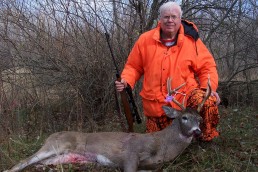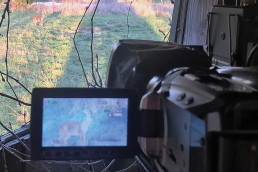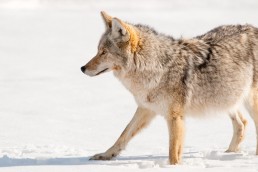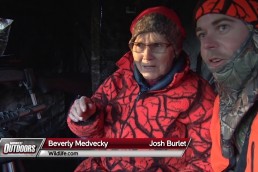Tips for Michigan’s Firearm Deer Season
SHARE THIS POST
It’s no secret that deer hunting here in the Great Lakes State is extremely popular, especially during the firearm deer season. Each fall, around a half-million hunters travel afield with gun in hand in pursuit of white-tailed deer in Michigan. Depending on how many other hunters you’re competing with in your hunting area, it doesn’t take long for deer to react to the onset of hunting pressure. Soon, they will head to the thickest, most impenetrable cover they can find in the area. You have to be ready to adapt in order to be successful. After all, we only have fifteen days to get some venison in the freezer. With that being said, here are five tips that have helped me fill my tag throughout the years. Hopefully, it will help you do the same this firearm deer season.
Organize your gear
Too many hunters wait until the last minute to look over all of their hunting gear before gun season begins. Instead of waiting until the night before the opener to gather your hunting gear and check to make sure you have everything, create a checklist of all the items you need several weeks in advance. Your checklist shouldn’t be limited to the following, but it’s a start: license, ammunition, hunting knife, rubber gloves, rope, binoculars and range finder, shooting stick hand warmers, extra warm clothes, compass or GPS, sandwich, snacks, water, etc.
There’s nothing worse than arriving at you deer blind or treestand and wishing you would’ve packed a particular item.
Blind and treestand setup
If you bowhunt like I do, then your treestands are already in place and ready for the season. However, most stands for bowhunters are set up for close shots of less than 40 yards, with the exception of ones that are set up along field edges. Depending on if you hunt in the shotgun or rifle zone, you will want to extend your shooting range by clearing out shooting lanes to increase your shot opportunities. Also, consider placing treestands in funnels between thick cover and a food source. When shots get underway, deer will frequent those trails that head to this escape cover.
Every gun season, I spend my opening day hunting from a permanent deer blind. If you hunt from one, it’s a good idea to check them ahead of time for any needed repairs. Last July, I added a coat of stain to my blind to help preserve it for future use. Also, inspect the blind for weathered steps and the roof for leaks. A little preventative maintenance in the summer months will help your blind last for years.
Even though it’s tradition for me to sit in my permanent blind on opening day, I like having options when deer become pressured. This year, I set up a pop-up blind in a stand of hardwoods near a thick deer bedding area. Be extremely cautious when hunting these types of areas. Choose your entry and exit routes carefully to avoid spooking deer. Also, brush in the blind so that it breaks up its outline and helps conceal you.
Hunt all day
On opening day, consider packing a lunch and hunting all day. If you hunt in a high-pressured area like me, avoid abandoning your stand or blind during midday for lunch. Most hunters head back to deer camp during this time, which can make for some exciting deer hunting. The commotion caused by these hunters as they leave for lunch and return will likely cause deer to move in your direction, offering you a possible shot opportunity. This same type of tactic should also be used when hunting on weekends. With more gun hunters in the woods, your chances of seeing numerous deer throughout the day is excellent. Refrain from taking a nap or lunch break, because the buck you’re waiting for could appear at any time, offering you a shot opportunity.
Besides packing a lunch, make sure to dress for the weather conditions. If it’s cold, dress with plenty of layers and pack extra warm clothes. Other items that will keep you on stand longer are hand warmers, a heater body suit, and boots with a high grain Thinsulate. Remember, the more comfortable you are, the longer you will remain in the deer woods, which is essential in tagging a mature whitetail.
Wind direction
Paying attention to the wind direction is just as important during the firearm deer season as it is during archery season. In most cases, depending on how many hunters are near your hunting location, the deer are under extreme pressure. Therefore, take extra caution when entering the woods and deciding which blind or stand to hunt from, based on the direction the wind is blowing. That’s why, as mentioned earlier, it’s so important to have several options to choose from. Whether you’re hunting from a deer blind or treestand, stay downwind of your shooting lanes, deer trails, food sources or other areas that you expect to see deer.
Are you enjoying this post?
You can be among the first to get the latest info on where to go, what to use and how to use it!
If you plan on still hunting for deer, use the wind to your advantage by walking directly into it. Windy days are a great time to still hunt because the deer can’t hear you coming as easily.
Sight in your gun
One of the most important tasks before venturing to deer camp is sighting in your gun. It is essential that you become proficient and confident with your firearm during the deer season. Always take the time to take a few shots during the weeks leading up to opening day. This will ensure that you place an accurate shot on a whitetail.
Using a firm rest such as a shooting rest or sandbags, fire your first shot at around 25 yards. I like using a large, 5- by 5-foot piece of plywood with a grid target. This allows me to easily see where my gun is shooting. The grid target has 1-inch squares that make it easy to adjust the elevation and windage. Another excellent type of target to use is Shoot-N-C targets. These reactive targets have a fluorescent chartreuse background that is covered with a black coating. When a bullet hits the target, a large blotch about twice the size of the bullet hole is left, allowing you to easily see it.
For most calibers, you will find that at 25 yards, you will be shooting a little low. This is fine, considering that the bullet hasn’t reached its full potential yet. After taking the first shot, I make the necessary adjustments to my scope by clicking the elevation and windage knobs. Afterwards, I take a second shot at the target, which should be just below the bullseye. Additional shots may be necessary to fine-tune where the bullet is striking. I then move the target out to 100 yards, which is the maximum distance that I usually shoot deer at. I will then take two to three shots, depending on where they’re hitting the target. In order to keep track of the shots on paper, I use a pen to number the shots so that I can make the proper corrections.
When sighting in my .30-06, I always use the same brand of ammunition and grain as I would when hunting, so that my shots are consistent.
Become a MidWest Outdoors Insider here!
MWO
SHARE THIS POST
Did you enjoy this post?
You can be among the first to get the latest info on where to go, what to use and how to use it!
Darin Potter
Darin Potter’s passion for outdoor writing began at the age of 12 when he first began writing in a journal that his parents bought him on a family camping trip in Northern Michigan. His writings have appeared in several Midwest publications: Michigan-Out-of-Doors, Michigan and Ohio Outdoor News, Modern Pioneer, and MidWest Outdoors.



